Page 4

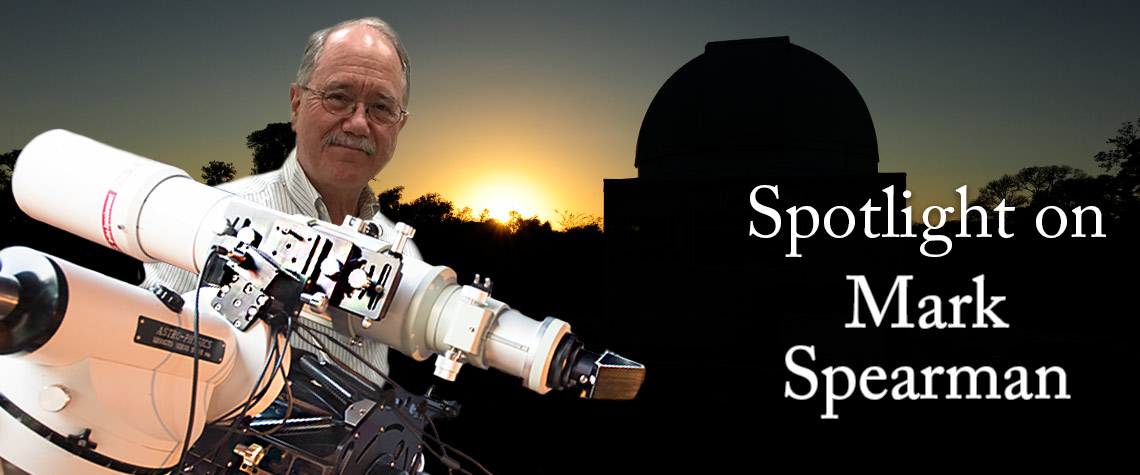
Mark Spearman - Astronomer, Outreach Volunteer, and Mentor
1. Tell us about yourself.
I am 64 years old and have lived in Texas for most of my life although I had 15 years of exile in Illinois, Georgia and Alabama. My undergraduate degree is physics from Sam Houston and then I obtained a masters and PhD in industrial engineering from TAMU. I was a professor of IE at Northwestern University, Georgia Tech, the University of Alabama, and at Texas A&M. Around 2001, I left the academy and started my own consulting business, Factory Physics, Inc. Last year, I sold that company to Strategic Project Solutions with whom I work now. I enjoy the challenges of applying advanced analytics to real world problems.
2. How did you become interested in astronomy?
When I was 10 years old, TAMU held a “Space Fiesta” in which they had models of NASA rockets, space suits, and all kinds of stuff that dealt with space. My first telescope was obtained after selling a dozen boxes of Christmas cards to (mostly) my mother’s friends. A few Christmas’s later, I had a Tasco 4.5" reflector and I was in “high cotton.” I had my first subscription to Sky and Telescope in 1967. I now see the covers of those magazines in the latest issue in the “50 Years Ago” section. It is sometimes hard to believe.
3. How long have you been involved with the hobby?
About 54 years.
4. What type of equipment do you currently use for observations?
I use three scopes. I have a TOA and an Astrotech RC 10 on a AP 1200 German equatorial mount. I also have a small Stellarvue 102 on a Vixen Alt-Az mount that I take with me camping.
5. Describe a normal night of observing?
While I used to try for beautiful images, nowadays I do mostly photometry of variable stars and extra solar transits. I leave the pretty pictures to Randy Light and others.
My night begins before dust by selecting a target for that night. The target needs to be high enough and the action (like a transit or an eclipse) needs to happen after I start imaging. Then, at dust I open the dome, start the camera and get it down to temperature and then begin taking flat fields in order to calibrate.
Once the object is in view, I begin the imaging session. I first select a guide star and re-train the mount-camera. Then I try for the best focus I can obtain. Finally, I begin imaging. After the imaging, I may take some dark and bias frames for calibration (although I sometimes use those in my library).
6. Do you have a favorite part of the sky and favorite time of the year to observe?
My favorite part of the sky is near the zenith because it has the least air to get in the way. I like the fall and winter because of the cool-cold and clear nights and because those seasons have some of the best objects. However, the summer also has great objects but it does not get dark until late and can be very hot even at night.
7. What is the most awe-inspiring object or event you have seen through your telescope?
The total eclipse of the sun in 2017 was the most awe inspiring. But I am always amazed whenever I view the Double Cluster in Perseus, the Great Nebula in Orion, and Omega Centauri when I am at the Texas Star Party.
8. What gives you the most satisfaction with your hobby?
Being able to collect data, analyze it, and find that it is useful. I submit good data to AAVSO, the American Association of Variable Star Observers.
9. Have you participated in any astronomical research? If so, please describe.
Yes. Extra-solar transits, eclipsing binary stars, and getting data for an AAVSO alert (when a professional astronomer asks for observations of a given object). I also like to image supernovae whenever they pop off in a relatively nearby galaxy. I made images SN in M51 and M82 and reported their light curves.
10. What do you like most about attending star parties?
Meeting people and sharing the viewing. Getting to know other's equipment. Helping beginners get started in a hobby I love.
11. Do you have any parting comments?
I want to encourage people who are new to the hobby to keep going and it will get easier. I also would like to suggest putting away the GOTO until you get somewhat familiar with the sky. This is a great hobby. I love going to new places and seeing the same stars (mostly) in different places depending on the latitude. The Dippers never get too high in Texas but they are almost directly overhead in England. We get to see Canopus in Central Texas, a star that people above 40 N never see! And if you go below the equator, everything is upside down! It is a great way to really have a feel for our place in the universe.
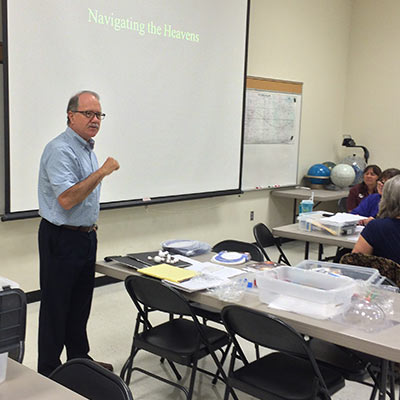
Presenting lesson to science teachers
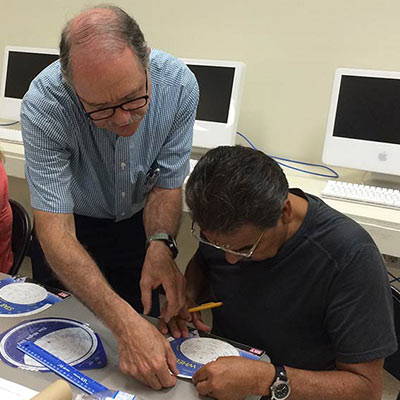
Demonstrating use of planisphere

Attending Texas Star Party
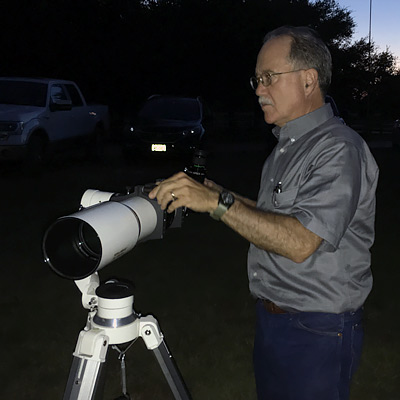
Preparing for Beautiful Abilities outreach night

Adjusting telescope via computer
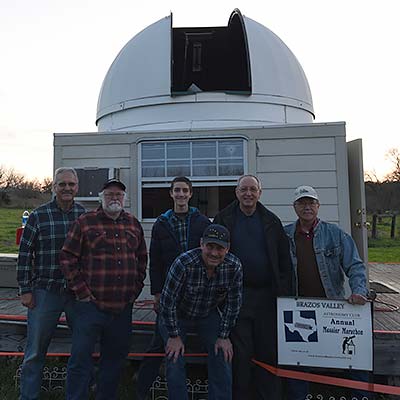
Hosting BVAC Messier Marathon
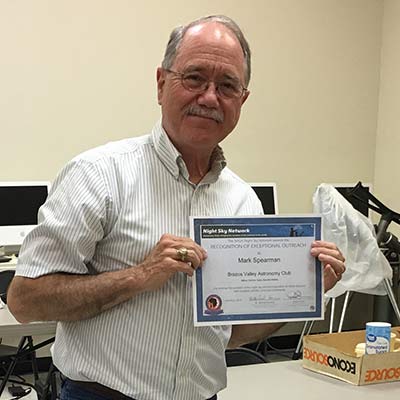
Receiving outreach award from Night Sky Network

Giving presentation to Brazos Valley Astronomy Club

Answering questions from audience about presentation
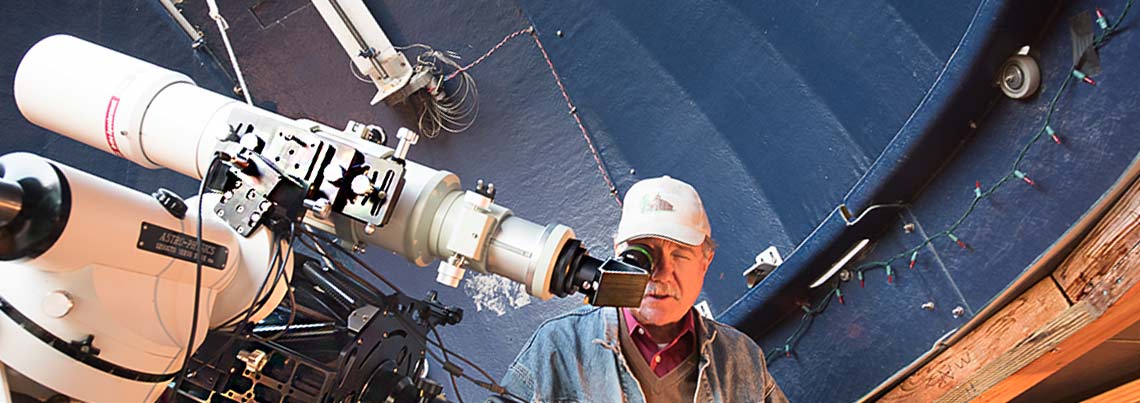
Preparing equipment for a night of observing at Regina Caelorum Observatory